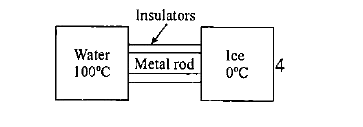An insulated contianer, filled with water, contains a thermometer and a paddle wheel. The paddle wheel can be rotated by an external source. This apparatus can be used to determine.
specific heat of water.
relation between kinetic energy and absolute temperature.
thermal conductivity of water.
mechanical equivalent of heat.
The correct Answer is:D
To determine the purpose of the insulated container filled with water, a thermometer, and a paddle wheel, we can analyze the situation step by step.
1. Understanding the Setup:
- We have an insulated container filled with water, which means that heat exchange with the environment is minimized.
- Inside the container, there is a thermometer to measure the temperature of the water.
- A paddle wheel is present, which can be rotated using an external source.
2. Function of the Paddle Wheel:
- When the paddle wheel is rotated, it does work on the water. This work done by the paddle wheel will cause the water to gain energy.
- Since the container is insulated, this energy will not escape to the surroundings, and the energy will be converted into thermal energy, thereby increasing the temperature of the water.
3. Measurement of Temperature Change:
- The thermometer will be used to measure the initial and final temperatures of the water.
- By knowing the amount of work done on the paddle wheel (which can be quantified), we can observe the corresponding change in temperature of the water.
4. Relating Work Done to Heat:
- The relationship between the work done on the paddle wheel and the heat gained by the water can be used to determine the mechanical equivalent of heat.
- The mechanical equivalent of heat is a concept that relates the amount of mechanical work done to the amount of heat produced.
5. Conclusion:
- Therefore, the apparatus can be used to determine the mechanical equivalent of heat, as it allows us to measure how much mechanical energy (work done by the paddle wheel) is converted into thermal energy (increase in temperature of the water).
Final Answer:
The apparatus can be used to determine the mechanical equivalent of heat.
---
- We have an insulated container filled with water, which means that heat exchange with the environment is minimized.
- Inside the container, there is a thermometer to measure the temperature of the water.
- A paddle wheel is present, which can be rotated using an external source.
- When the paddle wheel is rotated, it does work on the water. This work done by the paddle wheel will cause the water to gain energy.
- Since the container is insulated, this energy will not escape to the surroundings, and the energy will be converted into thermal energy, thereby increasing the temperature of the water.
- The thermometer will be used to measure the initial and final temperatures of the water.
- By knowing the amount of work done on the paddle wheel (which can be quantified), we can observe the corresponding change in temperature of the water.
- The relationship between the work done on the paddle wheel and the heat gained by the water can be used to determine the mechanical equivalent of heat.
- The mechanical equivalent of heat is a concept that relates the amount of mechanical work done to the amount of heat produced.
- Therefore, the apparatus can be used to determine the mechanical equivalent of heat, as it allows us to measure how much mechanical energy (work done by the paddle wheel) is converted into thermal energy (increase in temperature of the water).
The apparatus can be used to determine the mechanical equivalent of heat.
Topper's Solved these Questions
- BOOK - RESNICK AND HALLIDAYCHAPTER - HEAT-MEASUREMENT AND TRANSFEREXERCISE - PRACTICE QUESTIONS(MORE THAN ONE CORRECT CHOICE TYPE )8videos
HEAT-MEASUREMENT AND TRANSFER
- BOOK - RESNICK AND HALLIDAYCHAPTER - HEAT-MEASUREMENT AND TRANSFEREXERCISE - PRACTICE QUESTIONS( LINKED COMPREHENSION)9videos
HEAT-MEASUREMENT AND TRANSFER
- BOOK - RESNICK AND HALLIDAYCHAPTER - HEAT-MEASUREMENT AND TRANSFEREXERCISE - PROBLEMS35videos
HEAT-MEASUREMENT AND TRANSFER
- BOOK - RESNICK AND HALLIDAYCHAPTER - GRAVITATIONEXERCISE - PRACTICE QUESTIONS (INTEGER TYPE)4videos
GRAVITATION
- BOOK - RESNICK AND HALLIDAYCHAPTER - HYDROGEN ATOMEXERCISE - PRACTICE QUESTIONS(Integer Type)6videos
HYDROGEN ATOM
Similar Questions
Two thermometers A and B are calibrated in different scales. When both the termometers are placed in a container filled with hot water the mecury thread in the thermometer A has mvoed through divisions whereas the mercury thread in thermometer B has moved though 15 divisions. The reading on thermometers A and B are 20∘and40∘, respectively. if the lower fixed point fo the thermometer A is 0∘, determinet he lowe fixed pointt of the thermometer B.
View SolutionWhat would you conclude from the observation that cathode rays rotate a light paddle wheel placed in their path?
View Solution
Knowledge Check
- Question 1 - Select One
A thermally insulated rigid container of one litre volume contains a diatomic ideal gas at room temperature. A small paddle installed inside the container is rotated from the outside such that the pressure rises by 105Pa. The change in internal energy is close to
A0JB67JC150JD250J - Question 2 - Select One or More
An insulated container is filled with ice at 0∘C, and another container is filled with water that is continuously boiling at 100∘C. In series of experiments, the container connected by various, thick metal rods that pass through the walls of container as shown in the figure-4.46.
In the experiment- I: A copper rod is used and all ice melts is 20 minutes.
In the experiment - II: A steel rod of identical dimensions is used and all melts in 80 minutes.
In the experiment-III: Both the are used in parallel all ice melts in t10 minutes.
In the cxperiment-IV: Both rods are used in parallel all ice melts in t20
 AThe value of t10 is 100 minutesBThe value of t10 is 50 minutesCThe value of t20 is 16 minutesDThe value of t20 is 8 minutes
AThe value of t10 is 100 minutesBThe value of t10 is 50 minutesCThe value of t20 is 16 minutesDThe value of t20 is 8 minutes - Question 3 - Select One
A light paddle wheel placed in the path of________will rotate.
Acathode raysBα-raysCβ-raysDAll the above
What would you conclude from the observation that cathode rays rotate a light paddle wheel placed in their path ?
View SolutionFlowing water can rotate a turbine. Which type of energy is used up by the turbine ?
View SolutionRamesh fills a black and a white-coloured containr with an equal amount of water and leaves them in mid-day sun for about an hour. When he checks the temperature of water in both the containers using a thermometer, he finds that the water in the black-coloured container is hotter. Which of the following statements cannot be concluded from the given activity?
View SolutionAn insulated container is filled with a mixture of water and ice at tc=0∘C. Another container is filled with water that is continuously boiling at th=100∘C. In a series of experiments, the containers are connected by various thick rods that pass through the walls of the containers (see the diagram). The rod is insulated in such a way that there is no heat loss to surroundings. In experiment 1, a copper rod is used, and the ice melts in T1=2 min. In experiment 2, a steel rod of the same cross section is used, and the ice melts in T2=6 min. How long ( in min) would it take to melt the ice if the two rods are used "in series"?
 View Solution
View SolutionAn industrial solvent of 90% strength is prepared and stored Q in a 150 litres capacity container. The container is filled to 80% of its capacity. It is required to decrease the concentration of the solvent in the container to less than 60°%. For doing this, eithe pure water can be added to it and/or solution can be removed. But removal can only be done if there is no place for adding water. At a given time, only 10 litres of the solution can be added or removed. How many times should water be added to the solution?
View Solution

